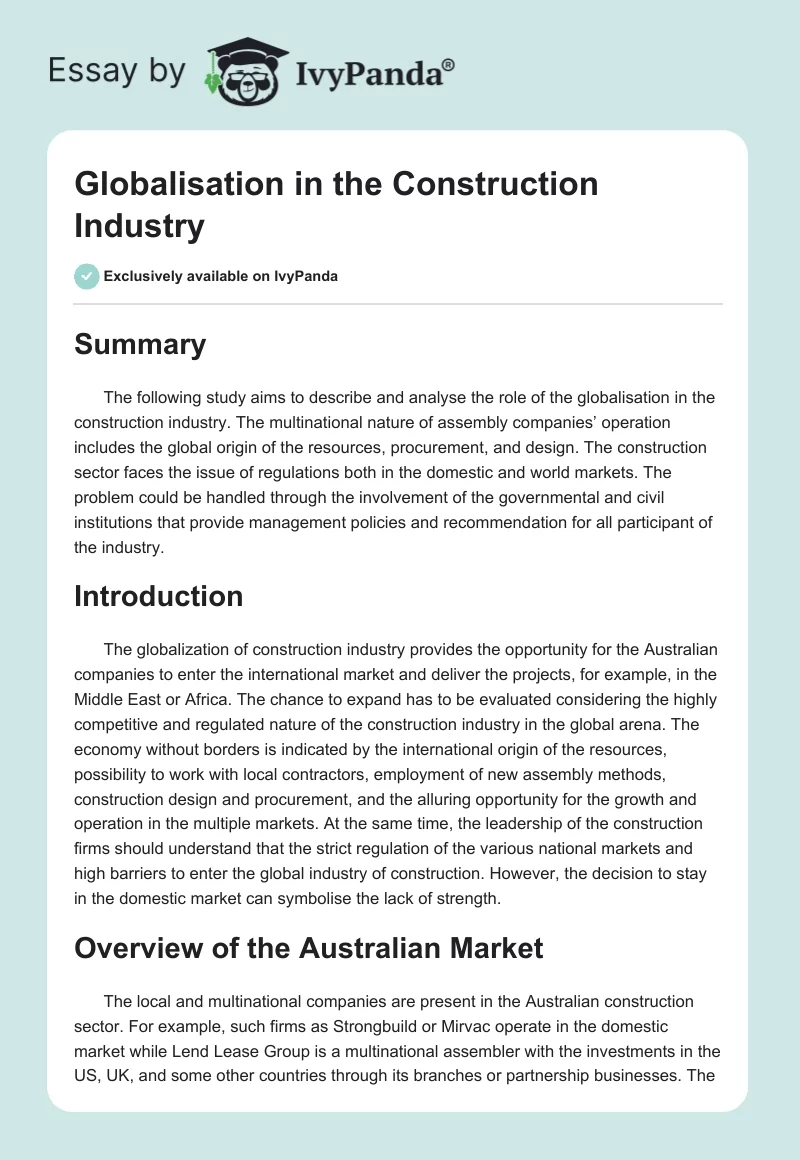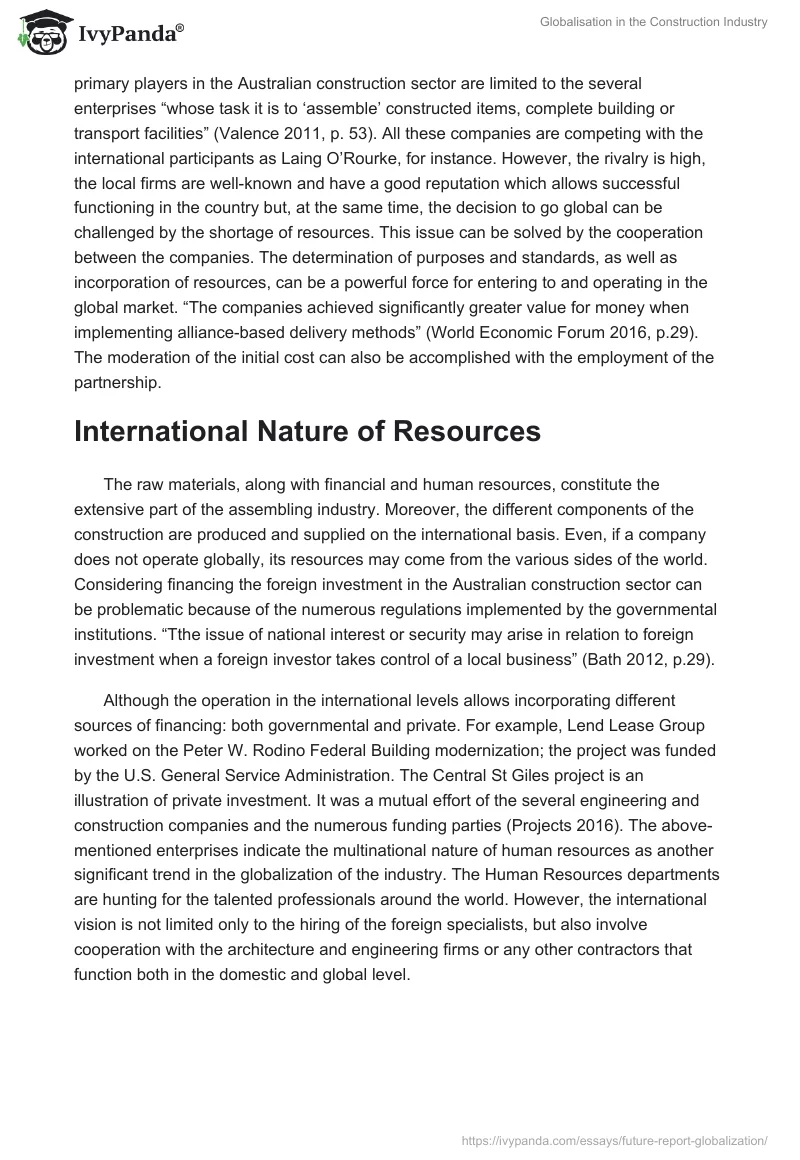Summary
The following study aims to describe and analyse the role of the globalisation in the construction industry. The multinational nature of assembly companies’ operation includes the global origin of the resources, procurement, and design. The construction sector faces the issue of regulations both in the domestic and world markets. The problem could be handled through the involvement of the governmental and civil institutions that provide management policies and recommendation for all participant of the industry.
Introduction
The globalization of construction industry provides the opportunity for the Australian companies to enter the international market and deliver the projects, for example, in the Middle East or Africa. The chance to expand has to be evaluated considering the highly competitive and regulated nature of the construction industry in the global arena. The economy without borders is indicated by the international origin of the resources, possibility to work with local contractors, employment of new assembly methods, construction design and procurement, and the alluring opportunity for the growth and operation in the multiple markets. At the same time, the leadership of the construction firms should understand that the strict regulation of the various national markets and high barriers to enter the global industry of construction. However, the decision to stay in the domestic market can symbolise the lack of strength.
Overview of the Australian Market
The local and multinational companies are present in the Australian construction sector. For example, such firms as Strongbuild or Mirvac operate in the domestic market while Lend Lease Group is a multinational assembler with the investments in the US, UK, and some other countries through its branches or partnership businesses. The primary players in the Australian construction sector are limited to the several enterprises “whose task it is to ‘assemble’ constructed items, complete building or transport facilities” (Valence 2011, p. 53). All these companies are competing with the international participants as Laing O’Rourke, for instance. However, the rivalry is high, the local firms are well-known and have a good reputation which allows successful functioning in the country but, at the same time, the decision to go global can be challenged by the shortage of resources. This issue can be solved by the cooperation between the companies. The determination of purposes and standards, as well as incorporation of resources, can be a powerful force for entering to and operating in the global market. “The companies achieved significantly greater value for money when implementing alliance-based delivery methods” (World Economic Forum 2016, p.29). The moderation of the initial cost can also be accomplished with the employment of the partnership.
International Nature of Resources
The raw materials, along with financial and human resources, constitute the extensive part of the assembling industry. Moreover, the different components of the construction are produced and supplied on the international basis. Even, if a company does not operate globally, its resources may come from the various sides of the world. Considering financing the foreign investment in the Australian construction sector can be problematic because of the numerous regulations implemented by the governmental institutions. “Tthe issue of national interest or security may arise in relation to foreign investment when a foreign investor takes control of a local business” (Bath 2012, p.29).
Although the operation in the international levels allows incorporating different sources of financing: both governmental and private. For example, Lend Lease Group worked on the Peter W. Rodino Federal Building modernization; the project was funded by the U.S. General Service Administration. The Central St Giles project is an illustration of private investment. It was a mutual effort of the several engineering and construction companies and the numerous funding parties (Projects 2016). The above-mentioned enterprises indicate the multinational nature of human resources as another significant trend in the globalization of the industry. The Human Resources departments are hunting for the talented professionals around the world. However, the international vision is not limited only to the hiring of the foreign specialists, but also involve cooperation with the architecture and engineering firms or any other contractors that function both in the domestic and global level.
Advanced procurement, construction design, and assembly methods
The evaluation of the globalisation influence on these processes leads to the conclusion that, however, the open borders make the work in the multinational market more intelligible, the globalisation also creates some obstacles that can be overcome with the help of the public institutions and the governments. As an industry with multiple players that can participate in one project, the construction sector requires the excellence in procurement, design, and assembly methods. The efficiency of these procedures can be challenged by the bureaucracy, corruption, and absence of transparent rules and regulations. The public procurement depends on the governmental actions and includes development and implementation of policies which simplify and make clearer the rules of participation for the local and international construction firms (World Economic Forum 2016, p.47).
Moreover, this is the role of a government in employing the anti-corruption trainings and initiate innovation in the industry. The establishment of international advisory boards or councils is a major step in fighting the problems of the procurement and assembly in the global market. For example, the Australian Procurement and Construction Council regulates the industry operation within the country through recommendations, development, and executing policies (Valence2011). In the global arena, the International Council for Research and Innovation in Building and Construction (CIB) employs the functions of an adviser and a ground for cooperation among the different members of the industry.
The globalisation of the sector levers the design of the projects and the assembly methods on the new level. The validity of the statement can be easily demonstrated by the completed or ongoing construction or modernisation works of Lens Lease Group and its partners. The firm’s projects, which were discussed before, were implemented with the collaboration of the independent professionals and architecture companies such as Renzo Piano Building Workshop which offers its services and expertise worldwide. Although the international cooperation is positive phenomena because it provides the great opportunities for numerous players to realise themselves, the question of the distinction of the projects through demonstration of the particular view on the design and functioning is open for discussion. As Valence claims that, nevertheless, the execution of the assembly industry is possible via application of various methods, “a model showing how the built environment is created through the project initiation, design and construction process are the most representative of the whole industry” (2010, p.63).
Conclusion
To sum up, the various aspects of the globalisation of the building sector and its impact on the future project delivery in Australia have positive and problematic sides. The domestic assembly companies are protected by governmental policies from the extensive presence of foreign investment. Considering the nature of the global market the protectionism may lead to the reduction of rivalry capacities of the local enterprises in the international market. However, the collaboration of several players, which has been successfully exercised by the Australian firms, provides them with competitive advantages in the global economy. The globalisation process implies participation of various actors which, from the one side, symbolises a genuinely multinational project, but, on the other hand, it may create tensions when the different players represent the incompatible visions on the work.
References
Bath, V 2012, ‘Foreign investment, the national interest and national security – foreign direct investment in Australia and China’, Sydney Law Review, vol. 34., no. 1, pp. 5-34.
Projects n.d., Web.
Valence, G 2011, ‘Defining an industry: What is the size and scope of the Australian Building and Construction Industry’, Australian Journal of Construction Economics and Building, vol. 1, no. 1, pp. 53-65.
World Economic Forum 2016, Shaping the future of the construction: A breakthrough in mindset and technology, Web.


